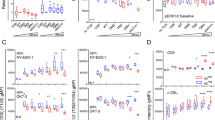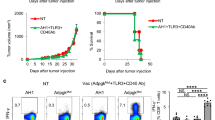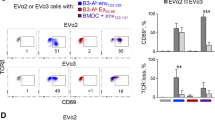Abstract
While the effects of TCR affinity and TGFβ on CD8+ T-cell function have been studied individually, the manner in which TCR affinity dictates susceptibility to TGFβ-mediated suppression remains unknown. To address this issue, we utilized OVA altered peptide ligands (APLs) of different affinities in the OT-I model. We demonstrate that while decreased TCR ligand affinity initially results in weakened responses, such interactions prime the resultant effector cells to respond more strongly to cognate antigen upon secondary exposure. Despite this, responses by CD8+ T cells primed with lower-affinity TCR ligands are more effectively regulated by TGFβ. Susceptibility to TGFβ-mediated suppression is associated with downregulation of RGS3, a recently recognized negative regulator of TGFβ signaling, but not expression of TGFβ receptors I/II. These results suggest a novel tolerance mechanism whereby CD8+ T cells are discriminately regulated by TGFβ according to the affinity of the ligand on which they were initially primed. In addition, because of the major role played by TGFβ in tumor-induced immune suppression, these results identify the affinity of the priming ligand as a primary concern in CD8+ T-cell-mediated cancer immunotherapeutic strategies.



Similar content being viewed by others
References
Zehn D, Lee SY, Bevan MJ (2009) Complete but curtailed T-cell response to very low-affinity antigen. Nature 458(7235):211–214. doi:10.1038/nature07657
Hommel M, Hodgkin PD (2007) TCR affinity promotes CD8+ T cell expansion by regulating survival. J Immunol 179(4):2250–2260
Blobe GC, Schiemann WP, Lodish HF (2000) Role of transforming growth factor beta in human disease. N Engl J Med 342(18):1350–1358. doi:10.1056/NEJM200005043421807
Chen W, Jin W, Hardegen N, Lei KJ, Li L, Marinos N, McGrady G, Wahl SM (2003) Conversion of peripheral CD4+CD25− naive T cells to CD4+CD25+ regulatory T cells by TGF-beta induction of transcription factor Foxp3. J Exp Med 198(12):1875–1886. doi:10.1084/jem.20030152jem.20030152
Kulkarni AB, Huh CG, Becker D, Geiser A, Lyght M, Flanders KC, Roberts AB, Sporn MB, Ward JM, Karlsson S (1993) Transforming growth factor beta 1 null mutation in mice causes excessive inflammatory response and early death. Proc Natl Acad Sci USA 90(2):770–774
Li MO, Wan YY, Sanjabi S, Robertson AK, Flavell RA (2006) Transforming growth factor-beta regulation of immune responses. Annu Rev Immunol 24:99–146. doi:10.1146/annurev.immunol.24.021605.090737
Mangan PR, Harrington LE, O’Quinn DB, Helms WS, Bullard DC, Elson CO, Hatton RD, Wahl SM, Schoeb TR, Weaver CT (2006) Transforming growth factor-beta induces development of the T(H)17 lineage. Nature 441(7090):231–234. doi:10.1038/nature04754
Massague J (2000) How cells read TGF-beta signals. Nat Rev Mol Cell Biol 1(3):169–178. doi:10.1038/35043051
Shi Y, Massague J (2003) Mechanisms of TGF-beta signaling from cell membrane to the nucleus. Cell 113(6):685–700
Yau DM, Sethakorn N, Taurin S, Kregel S, Sandbo N, Camoretti-Mercado B, Sperling AI, Dulin NO (2008) Regulation of Smad-mediated gene transcription by RGS3. Mol Pharmacol 73(5):1356–1361. doi:10.1124/mol.108.044990
Gorelik L, Flavell RA (2000) Abrogation of TGFbeta signaling in T cells leads to spontaneous T cell differentiation and autoimmune disease. Immunity 12(2):171–181
Marie JC, Liggitt D, Rudensky AY (2006) Cellular mechanisms of fatal early-onset autoimmunity in mice with the T cell-specific targeting of transforming growth factor-beta receptor. Immunity 25(3):441–454. doi:10.1016/j.immuni.2006.07.012
Fahlen L, Read S, Gorelik L, Hurst SD, Coffman RL, Flavell RA, Powrie F (2005) T cells that cannot respond to TGF-beta escape control by CD4(+)CD25(+) regulatory T cells. J Exp Med 201(5):737–746. doi:10.1084/jem.20040685
Gorelik L, Flavell RA (2001) Immune-mediated eradication of tumors through the blockade of transforming growth factor-beta signaling in T cells. Nat Med 7(10):1118–1122. doi:10.1038/nm1001-1118nm1001-1118
Dulin NO, Sorokin A, Reed E, Elliott S, Kehrl JH, Dunn MJ (1999) RGS3 inhibits G protein-mediated signaling via translocation to the membrane and binding to Galpha11. Mol Cell Biol 19(1):714–723
Zloza A, Jagoda MC, Lyons GE, Graves MC, Kohlhapp FJ, O’Sullivan JA, Lacek AT, Nishimura MI, Guevara-Patino JA (2011) CD8 Co-receptor promotes susceptibility of CD8(+) T cells to transforming growth factor-beta (TGF-beta)-mediated suppression. Cancer Immunol Immunother. doi:10.1007/s00262-010-0962-6
Beveridge NE, Price DA, Casazza JP, Pathan AA, Sander CR, Asher TE, Ambrozak DR, Precopio ML, Scheinberg P, Alder NC, Roederer M, Koup RA, Douek DC, Hill AV, McShane H (2007) Immunisation with BCG and recombinant MVA85A induces long-lasting, polyfunctional mycobacterium tuberculosis-specific CD4+ memory T lymphocyte populations. Eur J Immunol 37(11):3089–3100. doi:10.1002/eji.200737504
Precopio ML, Betts MR, Parrino J, Price DA, Gostick E, Ambrozak DR, Asher TE, Douek DC, Harari A, Pantaleo G, Bailer R, Graham BS, Roederer M, Koup RA (2007) Immunization with vaccinia virus induces polyfunctional and phenotypically distinctive CD8(+) T cell responses. J Exp Med 204(6):1405–1416. doi:10.1084/jem.20062363
Betts MR, Nason MC, West SM, De Rosa SC, Migueles SA, Abraham J, Lederman MM, Benito JM, Goepfert PA, Connors M, Roederer M, Koup RA (2006) HIV nonprogressors preferentially maintain highly functional HIV-specific CD8+ T cells. Blood 107(12):4781–4789. doi:10.1182/blood-2005-12-4818
Betts MR, Price DA, Brenchley JM, Lore K, Guenaga FJ, Smed-Sorensen A, Ambrozak DR, Migueles SA, Connors M, Roederer M, Douek DC, Koup RA (2004) The functional profile of primary human antiviral CD8+ T cell effector activity is dictated by cognate peptide concentration. J Immunol 172(10):6407–6417
Kroger CJ, Alexander-Miller MA (2007) Dose-dependent modulation of CD8 and functional avidity as a result of peptide encounter. Immunology 122(2):167–178. doi:10.1111/j.1365-2567.2007.02622.x
Kroger CJ, Alexander-Miller MA (2007) Cutting edge: CD8+ T cell clones possess the potential to differentiate into both high- and low-avidity effector cells. J Immunol 179(2):748–751
Desser L, Holomanova D, Zavadova E, Pavelka K, Mohr T, Herbacek I (2001) Oral therapy with proteolytic enzymes decreases excessive TGF-beta levels in human blood. Cancer Chemother Pharmacol 47(Suppl):10–15
Pircher H, Rohrer UH, Moskophidis D, Zinkernagel RM, Hengartner H (1991) Lower receptor avidity required for thymic clonal deletion than for effector T-cell function. Nature 351(6326):482–485. doi:10.1038/351482a0
Sant’Angelo DB, Janeway CA Jr (2002) Negative selection of thymocytes expressing the D10 TCR. Proc Natl Acad Sci USA 99(10):6931–6936. doi:10.1073/pnas.10218249999/10/6931
Bellavance EC, Kohlhapp FJ, Zloza A, O’Sullivan JA, McCracken J, Jagoda MC, Lacek AT, Posner MC, Guevara-Patino JA (2011) Development of tumor-infiltrating CD8+ T cell memory precursor effector cells and antimelanoma memory responses are the result of vaccination and TGF-beta blockade during the perioperative period of tumor resection. J Immunol 186(6):3309–3316. doi:10.4049/jimmunol.1002549
Sanjabi S, Mosaheb MM, Flavell RA (2009) Opposing effects of TGF-beta and IL-15 cytokines control the number of short-lived effector CD8+ T cells. Immunity 31(1):131–144. doi:10.1016/j.immuni.2009.04.020
Leignadier J, Labrecque N (2010) Epitope density influences CD8+ memory T cell differentiation. PLoS One 5(10):e13740. doi:10.1371/journal.pone.0013740
Obar JJ, Lefrancois L (2010) Early signals during CD8 T cell priming regulate the generation of central memory cells. J Immunol 185(1):263–272. doi:10.4049/jimmunol.1000492
Shi GX, Harrison K, Han SB, Moratz C, Kehrl JH (2004) Toll-like receptor signaling alters the expression of regulator of G protein signaling proteins in dendritic cells: implications for G protein-coupled receptor signaling. J Immunol 172(9):5175–5184
Reif K, Cyster JG (2000) RGS molecule expression in murine B lymphocytes and ability to down-regulate chemotaxis to lymphoid chemokines. J Immunol 164(9):4720–4729
Acknowledgments
We are grateful to Mary Jo Turk (Dartmouth Medical School, NH) and Anne Sperling (The University of Chicago, IL) for constructive discussions and the Flow Cytometry Facility at The University of Chicago for its invaluable support. This work was supported by the American Cancer Society (ACSLIB112496-RSG, to J.A.G.), American Cancer Society–Illinois Division (Young Investigator Award Grant #07-20, to J.A.G.), the National Institutes of Health (R21CA127037-01A1 to J.A.G. and R01GM85058 to N.O.D.), Cancer Research Foundation (Young Investigator Award, to J.A.G.), and the National Institutes of Health (T32 Immunology Training Grant, The University of Chicago, AI007090 to J.A.O., A.Z., and F.J.K.). The authors have no financial conflicts of interest to disclose.
Author information
Authors and Affiliations
Corresponding author
Electronic supplementary material
Below is the link to the electronic supplementary material.
262_2011_1043_MOESM1_ESM.tif
Expression of CD3 and CD8 is not affected by priming ligand affinity. OT-I cells were primed with the various ligands and incubated as described in Fig. 1. At day 5 after priming, the cells were analyzed for surface expression of CD3 and CD8. Expression levels of these markers are shown in offset histograms. Data shown are representative of at least three individual experiments with similar results (TIFF 120 kb)
262_2011_1043_MOESM2_ESM.tif
Neither ligand affinity nor TGFβ signaling affects CD8+ T-cell activation status markers. OT-I cells were primed with the various ligands and incubated as shown in Fig. 1. At day 5, the cells were analyzed for surface expression of CD44, CD62L, KLRG1, and CD127 and intracellular expression of the transcription factors T-bet and Eomes. Each histogram indicates the expression level of the marker in CD3+CD8+ cells incubated in the presence or absence of 20 ng/ml TGFβ. Data shown are representative of at least three individual experiments with similar results (TIFF 338 kb)
262_2011_1043_MOESM3_ESM.tif
Initial responses to OVA APLs. OT-I splenocytes were stimulated in vitro for 8 h with decreasing concentrations of OVA257 or the APLs. Following stimulation, cells were analyzed for polycytokine production. The data were fit with sigmoidal dose–response curves. Separate curves were accepted for each peptide as the extra sum-of-squares F test yielded P values less than 0.0001 for each plot. Data shown are representative of at least three individual experiments with similar results (TIFF 130 kb)
262_2011_1043_MOESM4_ESM.tif
No affinity-dependent phenotypic changes are observed before the addition of TGFβ. OT-I cells were primed with the various ligands and incubated as described for the first 2 days. The cells were then analyzed by flow cytometry. Expression levels of CD3, CD44, CD62L, RGS3, TGFβRI, TGFβRII, KLRG1, CD127, and T-bet are shown in offset histograms. Data shown are representative of at least three individual experiments with similar results (TIFF 390 kb)
Rights and permissions
About this article
Cite this article
O’Sullivan, J.A., Zloza, A., Kohlhapp, F.J. et al. Priming with very low-affinity peptide ligands gives rise to CD8+ T-cell effectors with enhanced function but with greater susceptibility to transforming growth factor (TGF)β-mediated suppression. Cancer Immunol Immunother 60, 1543–1551 (2011). https://doi.org/10.1007/s00262-011-1043-1
Received:
Accepted:
Published:
Issue Date:
DOI: https://doi.org/10.1007/s00262-011-1043-1




